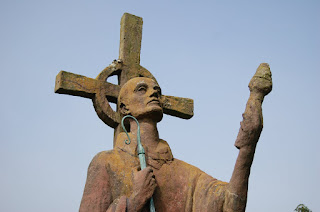The window in Cuthbert's chapel on the Farne Islands

A few shots of Lindisfarne today


There has been for a number of years an in intense interest in Celtic Christianity. When you read the first-hand accounts of the heroic labours and saintly lives of Columban and Aiden and Cuthbert a feeling of nostalgia arises, a feeling that this movement represents a form of authentic indigenous Christianity that we can all learn from. The Celtic church seems at first view to be a truly British and Irish phenomena that seems to untouched by the growing power and influence of the Roman church on the continent. Above all, many feel we can copy and learn and even immerse ourselves in Celtic Christian culture.
Most of this is of doubtful validity. The Celtic church was in no way an independent church. Even in turbulent times which saw the final withdrawal of the Roman legions from Britain and the Anglo-Saxon invasions along the East Coast, we were never cut off from what was happening on the Continent. They were never rebels against what was going on in Rome. They believed in a unified church. The Celts only differed in several minor ways: they calculated Easter differently. their tonsure (shaving of the head) and slight variations in their rite.
If a modern Christian were to be transported to Lindisfarne or York at this period he or she would find themselves in an alien land. The long services were all in Latin, with extensive periods of the liturgical chanting of the psalms. The sermons would, among other things, declaim the virtues of asceticism and the superiority of celibacy over marriage. Nearby would be a monastery where the tonsured monks lived lives of such self-denial that would make the average modern Christian shudder. On Columban's mission to the Continent it is said that he ate little more than herbs, berries and the bark of young trees.
I have noted that several Celtic communities have sprung up around the world in past thirty years, but none of them has, as far as I know, imitated the central beam of their mission thrust - the rejection of marriage and the embracing of an extreme ascetical life style, in order to be totally free to evangelise. I feel that there has been a lot of cherry picking here.
Having said all this negative stuff. I still believe that the Celtic Christians have a lot that we can aspire to and learn from. But that will be for another post.

Interesting more in-depth information than I already had Brian.
ReplyDeleteThis is true Brian but there is something in their model that speaks to hearts today that are full up to the brim with a 'me culture'. Those of us who prayerwalk - and there are many walking big and small - seek to walk with the same spirit of joy, shedding as many of the cultural accoutrements we have accumulated as we can, and choosing at least for a period, to keep things simple. Not entirely possible on tarmac and with Costa available, but dipping in and out at least into touching the land and feeling the heart of the people. Let's see some of that in your next post perhaps?
ReplyDelete(And I haven't even got started on the peregrinati perspective yet!)
Bless.
Jane